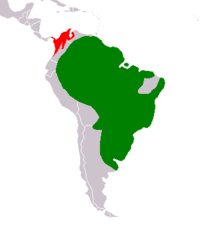Hydrochoerus
| Hydrochoerus Temporal range: Pleistocene - Recent | |
|---|---|
.jpg) | |
| H. hydrochaeris with a cattle tyrant on its back | |
| Scientific classification | |
| Kingdom: | Animalia |
| Phylum: | Chordata |
| Clade: | Synapsida |
| Class: | Mammalia |
| Order: | Rodentia |
| Family: | Caviidae |
| Subfamily: | Hydrochoerinae |
| Genus: | Hydrochoerus Brisson, 1762 |
| Species | |
 | |
| Ranges of capybara (green) and lesser capybara (red) | |
The genus Hydrochoerus contains two living species of capybaras from South America and Panama,[1] the largest living rodents in the world. The genus name is derived from the Greek ὕδωρ (hýdor, water) plus χοίρος (choíros, pig).
Characteristics
Capybaras are semiaquatic, found in and near lakes, rivers, swamps and flooded savanna. Their diets are dominated by grasses. Adults weigh up to 65 kg (140 lb). The gestation period is 130–150 days, with two to eight (most commonly four) young born to females.
Behavior
Capybaras are highly social, living in groups of up to 100 and communicating through a variety of vocalizations.[2] Breeding is polygynous, with males forming harems.
Phylogeny and taxonomy
Molecular results have consistently suggested Hydrochoerus is most closely related to Kerodon (the rock cavies), and the two evolved from within the Caviidae.[3] This led Woods and Kilpatrick to unite the two into the subfamily Hydrochoerinae within Caviidae.[1] Based on use of a molecular clock approach, Hydrochoerus appears to have diverged from Kerodon in the late Middle Miocene (about 12 million years ago).[4]
The extinct North American species formerly recognized as Hydrochoerus holmesi is now assigned to Neochoerus.[5]
Species
- Genus Hydrochoerus
- Hydrochoerus gaylordi (an extinct capybara endemic to Grenada)[6]
- Hydrochoerus hydrochaeris - capybara
- Hydrochoerus isthmius - lesser capybara
References
- 1 2 Woods, C.A.; Kilpatrick, C.W. (2005). "Infraorder Hystricognathi". In Wilson, D.E.; Reeder, D.M. Mammal Species of the World: A Taxonomic and Geographic Reference (3rd ed.). Johns Hopkins University Press. pp. 1538–1600. ISBN 978-0-8018-8221-0. OCLC 62265494.
- ↑ Rowe and Honeycutt, 2003
- ↑ Rowe, D. L.; Honeycutt, R. L. (2002). "Phylogenetic relationships, ecological correlates, and molecular evolution within the Cavioidea (Mammalia, Rodentia)". Molecular Biology and Evolution. 19 (3): 263–277. doi:10.1093/oxfordjournals.molbev.a004080. ISSN 0737-4038. PMID 11861886. Retrieved 2011-10-03.
- ↑ Opazo, J. C. (2005-08-08). "A molecular timescale for Caviomorph rodents (Mammalia, Hystricognathi)". Molecular Phylogenetics and Evolution. 37 (3): 932–937. doi:10.1016/j.ympev.2005.05.002. PMID 16085429. Retrieved 2011-10-03.
- ↑ "Neochoerus aesopi Leidy 1853 (caviomorph)". Fossilworks. Retrieved 2016-05-16.
- ↑ MacPhee, R. D. E.; Singer, R.; Diamond, M. (2000). "Late Cenozoic land mammals from Grenada, Lesser Antillean island-arc". American Museum Novitates. 3302: 1–20. doi:10.1206/0003-0082(2000)3302<0001:lclmfg>2.0.co;2. Retrieved 2012-08-29.
Further reading
- Nowak, Ronald M. 1999. Walker's Mammals of the World, 6th edition. Johns Hopkins University Press, 1936 pp. ISBN 0-8018-5789-9